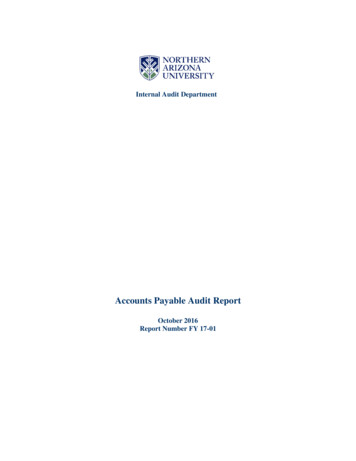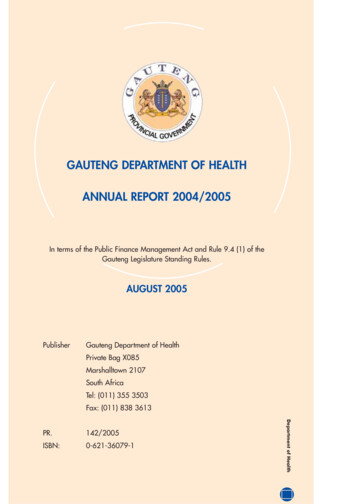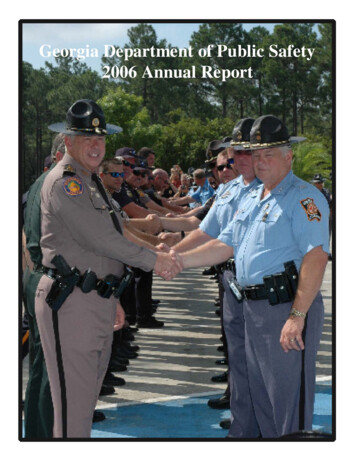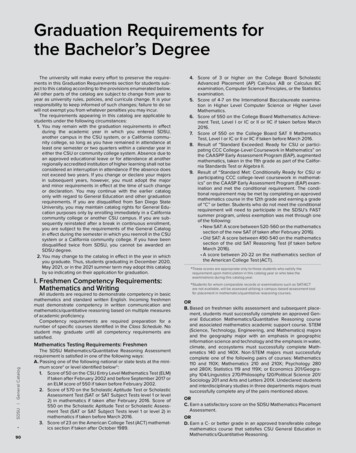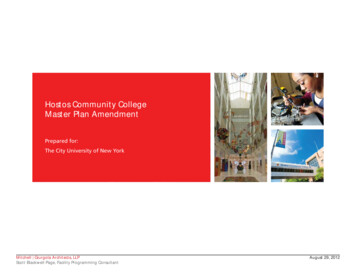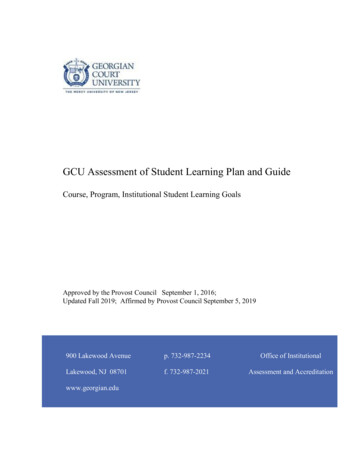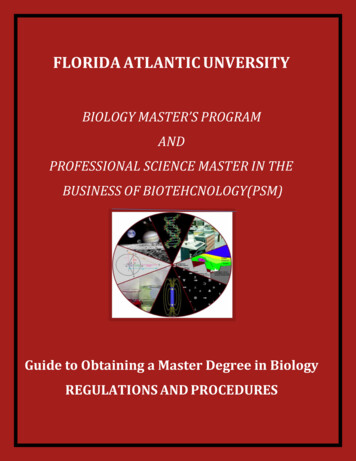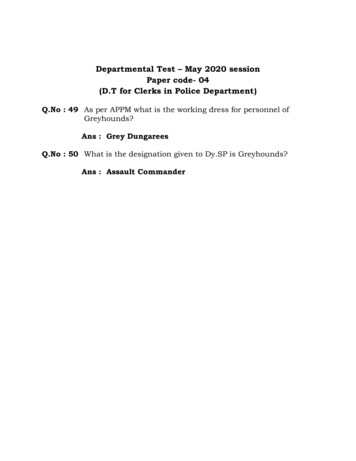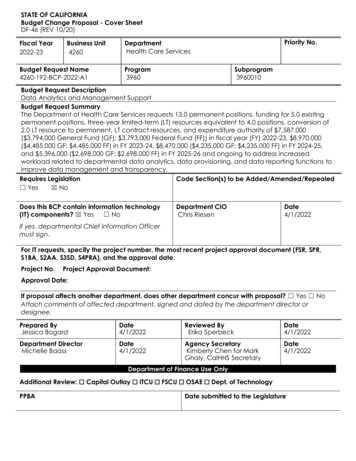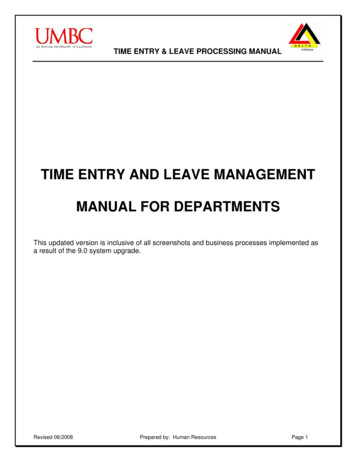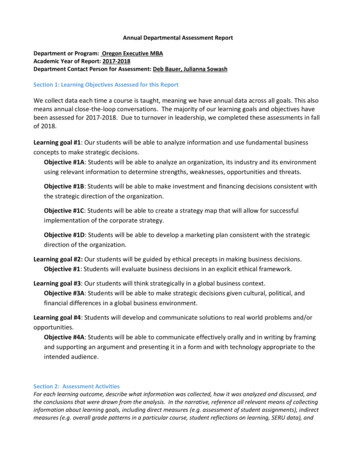
Transcription
Annual Departmental Assessment ReportDepartment or Program: Oregon Executive MBAAcademic Year of Report: 2017-2018Department Contact Person for Assessment: Deb Bauer, Julianna SowashSection 1: Learning Objectives Assessed for this ReportWe collect data each time a course is taught, meaning we have annual data across all goals. This alsomeans annual close-the-loop conversations. The majority of our learning goals and objectives havebeen assessed for 2017-2018. Due to turnover in leadership, we completed these assessments in fallof 2018.Learning goal #1: Our students will be able to analyze information and use fundamental businessconcepts to make strategic decisions.Objective #1A: Students will be able to analyze an organization, its industry and its environmentusing relevant information to determine strengths, weaknesses, opportunities and threats.Objective #1B: Students will be able to make investment and financing decisions consistent withthe strategic direction of the organization.Objective #1C: Students will be able to create a strategy map that will allow for successfulimplementation of the corporate strategy.Objective #1D: Students will be able to develop a marketing plan consistent with the strategicdirection of the organization.Learning goal #2: Our students will be guided by ethical precepts in making business decisions.Objective #1: Students will evaluate business decisions in an explicit ethical framework.Learning goal #3: Our students will think strategically in a global business context.Objective #3A: Students will be able to make strategic decisions given cultural, political, andfinancial differences in a global business environment.Learning goal #4: Students will develop and communicate solutions to real world problems and/oropportunities.Objective #4A: Students will be able to communicate effectively orally and in writing by framingand supporting an argument and presenting it in a form and with technology appropriate to theintended audience.Section 2: Assessment ActivitiesFor each learning outcome, describe what information was collected, how it was analyzed and discussed, andthe conclusions that were drawn from the analysis. In the narrative, reference all relevant means of collectinginformation about learning goals, including direct measures (e.g. assessment of student assignments), indirectmeasures (e.g. overall grade patterns in a particular course, student reflections on learning, SERU data), and
qualitative information (e.g. faculty observations, student input). While the choice of which assessments aremost meaningful is up to the department, a mix of direct and indirect measures is requested.For each of the learning objectives above, we collected the data described in the appendix to thisdocument. The data was then analyzed and discussed in the Academic Committee meeting in fall of2018. The results of that discussion are provided below.Goal #1: Our students will be able to analyze information and use fundamental businessconcepts to make strategic decisions. Objective #1A: Students will be able to analyze an organization, its industry and itsenvironment using relevant information to determine strengths, weaknesses, opportunitiesand threats. (BA723)# of Students # of Students Who # of Students Who % of StudentsAcademic # StudentsWho Did NotMeet SomeExceed or 3474794Closing the LoopEvaluation & Committee RecommendationFall 2018The committee notes that there is a downward trend in the data. We will await data from 2018 toevaluate if that continues and investigate if there may be a fundamental driver for the decrease. Therubric and standards continue to be deemed appropriate. We will also communicate with theinstructor to see if there are components missing from student’s knowledge. Also of note is that thisand the BA719 course are closely coordinated and both had decreases in meeting the standard. Objective #1B: Students will be able to make investment and financing decisions consistentwith the strategic direction of the organization. (BA720)Standard: Exceeds or meets expectations meets the standard. Exceeds is a score of 85%-100%; Meetsis 70-85%; Meets Some is 51-70%: and Does Not Meet is under 50%.# of StudentsAcademic # StudentsWho Did 14# of Students Who # of Students WhoMeet SomeExceed or MeetExpectationsExpectations112119181125% of StudentsMeetingStandard4246.250
Closing the LoopEvaluation & Committee RecommendationFall 2018As noted in the historical data, this course has been problematic. The hoped-for improvement inresults did not occur. Thus, the program has altered the delivery of this course and has identified anew instructor – an award-winning professor in our on-campus MBA program. The committee willwork with this new professor to establish a new rubric for measuring this outcome Objective #1C: Students will be able to create a strategy map that will allow for successfulimplementation of the corporate strategy. (BA725)# of StudentsAcademic # StudentsWho Did NotYearAssessedMeet2017-185002016-173902015-16500# of Students Who # of Students WhoMeet SomeExceed or MeetExpectationsExpectations050039149% of StudentsMeetingStandard10010098Closing the LoopEvaluation & Committee RecommendationFall 2018The Academic Committee has reviewed the results of the assessments and is satisfied with the targetgoals, standards that have been established, process, and results. Objective #1D: Students will be able to develop a marketing plan consistent with the strategicdirection of the organization. (BA719)# of StudentsAcademic # StudentsWho Did NotYearAssessedMeet2017-185002016-173902015-16500# of Students Who # of Students WhoMeet SomeExceed or MeetExpectationsExpectations1040039050Closing the LoopEvaluation & Committee RecommendationFall 2018% of StudentsMeetingStandard80100100
The committee notes that there is a reduction in the % of students meeting that standard slightlybelow the target. We will await data from 2018 to evaluate if that continues and investigate if theremay be a fundamental driver for the decrease. The rubric and standards continue to be deemedappropriate. Also of note is that this and the BA723 course are closely coordinated and both haddecreases in meeting the standard.Goal #2: Our students will be guided by ethical precepts in making business decisions.(BA730)Objective #2: Students will evaluate business decisions in an explicit ethical framework# ofStudentsWho DidNot MeetAcademic # # of Students WhoMeet SomeExpectations191613# of Students WhoExceed or MeetExpectations283124% of StudentsMeetingStandard566258.5Closing the LoopEvaluation & Committee RecommendationFall 2018Given that we have consistently missed this target the Academic Director spoke with the instructor toevaluate the issues. The instructor advised that the instrument is five questions and many studentsare missing two. The instructor previously thought that wordsmithing would help the studentsunderstand those questions but they continue to not understand the questions. The instructor notedthat it was not that they did not understand the fundamentals of the material. He advised that hewould update the instrument used to better measure student learning objectives. The AcademicCommittee will revisit this when we receive the latest data and instrument.Goal #3: Our students will think strategically in a global business context. (BA726) Objective #3: Students will be able to make strategic decisions given cultural, political, andfinancial differences in a global business environment.# of StudentsAcademic # StudentsWho Did NotYearAssessedMeet2017-185002016-174112015-16505# of Students Who # of Students WhoMeet SomeExceed or MeetExpectationsExpectations644238937% of StudentsMeetingStandard889374
Closing the LoopEvaluation & Committee RecommendationFall 2018The rubric and instrument have been updated as IES was not deemed to allow us to appropriatelymeasure this objective. The committee notes that the rubric is measuring their writing and does notaddress the objective. This will need to be revised and reevaluated by the Academic Committee. Thestaffing of this course may be changing and we will work with the new faculty member on accuratelymeasuring this objective. Objective #4A: Students will be able to communicate effectively orally and in writing byframing and supporting an argument and presenting it in a form and with technologyappropriate to the intended audience.# of StudentsAcademic # StudentsWho Did 014-15242# of Students WhoMeet SomeExpectations4232# of Students WhoExceed or MeetExpectations46364520% of StudentsMeetingStandard92959083Closing the LoopEvaluation & Committee RecommendationFall 2018The Academic Committee has reviewed the results of the assessments and is satisfied with the targetgoals and results. Given that we have a new capstone advisor, she will review the rubric weights andquestions to ensure alignment with our goals. She will propose improvements to academiccommittee to be approved and then shared with all capstone advisors.The Oregon Executive MBA also holds listening sessions with current students to solicit their feedbackon academic and curricular issues. The student voice gives us insight, beyond course evaluations, oftheir experience of the curriculum as a whole.Section 3: Actions Taken Based on Assessment AnalysisFor each learning goal assessed for each major, describe any actions taken as a result of assessmentinformation, or plans to take action during the next academic year. Describe how the actions or action plansare meant to address the issues arrived at through the assessment activities in Section 2.
Addressed above and in section 4.Section 4: Other Efforts to Improve the Student Educational ExperienceBriefly describe other continuous improvement efforts that are not directly related to the learning goals above.In other words, what activity has the department engaged in to improve the student educational experience?This might include changes such as curriculum revisions, new advising approaches, revised or new co-curricularactivities, etc. Describe the rationale for the change(s) and any outcomes resulting from the change(s).Each academic year, the program’s Academic Committee holds student feedback sessions regardingboth academic and operational topics. Following the sessions, the program provides written feedbackto students and notes any changes that will be implemented as a direct result of their feedback. Overmany years, changes that are a result of student feedback range from course order, course contentsuggestions, global trip calendaring, food service changes, classroomheating/cooling/audio/technology, team coaching requests, and changes in use of Canvas learningmanagement system.For example:Students requested that faculty receive, grade, and return assignments inside Canvas. Previously,students were working outside of Canvas and emailing assignments directly to faculty. To execute thischange, the program had to inform faculty that all assignments would be accepted, graded, andreturned within the learning management system. The program also needed to demonstrate/trainadjunct faculty on how to grade in Canvas. Students also required a demonstration on how to viewdetailed grading comments in Canvas. All of this was completed at the beginning of fall term.Some of the recent changes are below:Add: Associate Director of Student Services and Student Services SuiteIn order to address the needs of 200 graduate students in Portland, and to be consistent withstudent services on our main campus in Eugene, we staffed a full time position of AssociateDirector of Student Services. This role supports all 100 Oregon Executive MBA students. To bevisible and accessible, the program set up a Student Services Suite on the main floor of theteaching facility for drop in assistance. The Associate Director of Student Services supports theGlobal Trip, social programming (women’s networking, diversity events) studentcommunications newsletters, and has oversight on team coaching, and any special requirementsthat students have for accommodation, we have also added two classified staff members to herteam to manage a significant amount of work.Add: Director of ProgramIn order to provide best in class structure for the program, we have added a strong operationalrole of Director to the team. This position is the lead student facing role and develops improvedsystems and processes to raise student satisfaction with the program. This Director hasimplemented significant improvements in communications, efficiencies in on boarding newstudents, facilitated Canvas adoption and many other operational improvements. A recentfeedback session indicated strong student satisfaction with the program’s operationaleffectiveness.Add: Programming around diversity and women’s groupsAs mentioned above, based on student requests, we have developed programming for currentstudent’s networking. The affinity groups are for women and our diverse student population.
These events are developed with students and for students, by the Associate Director of StudentServices.Add: Executive Coaching and sessions to introduce coachesBased on industry trends and as requested by students, we have provided each student with upto four one hour sessions with a certified executive coach. Coaches work with students oncreating plans to move forward in their careers. We have added lunch introductorypresentations for students to connect with Executive Coaches and help them select which coachthey would like to work with.Add: Capstone Coordinator to build out structure of deliverables and organize the team of 10 AcademicAdvisorsBased on student feedback, the Capstone experience needed more consistency acrossadvisors/graders. In order to serve 50 students who are completing a significant 7 creditproject and presentation, an overall Coordinator was created. The Coordinator has produceddocumentation for all advisors to reference, created consistent partial and final deliverydeadlines, and communicated delivery and grading expectations to both advisors and students.After the full year is completed, we will evaluate the success of the new role based on studentevaluations.Incorporate: full features of Canvas – Learning Management System for students. Require faculty touse syllabus template and receive/grade assignments in Canvas.Add: BA 710 Technology and Innovation courseThis course was implemented based on student feedback and the Academic Committee’s desire tohave a course which provides perspective on changes that are coming to all businesses in the nearfuture with the emphasis on technology’s disruptive impact.Move: BA 708 Global experience (trip) to the beginning of year two. Tie first year Global Environmentcourse closely to Global experience through same Instructor oversight and taking pre and post IES(Intercultural Effectiveness Scale) instrument.Based on student feedback, the global trip was moved to the beginning of the 2nd academicyear (September). The instructor who teaches the first year course has oversight of the onecredit global experience course and assists with execution of the trip by engaging with our 3rdparty provider. The Instructor also provides a pre and post trip IES assessment.For the following courses (BA 708, BA 712, BA 717, BA 719, BA 720, BA 718) credit hours werechanged for the following reason: In 2016, we did a thorough curriculum review and changed ourschedule to every-other-week, to align with our students travel schedules and best practices acrossthe nation for EMBA programs. To meet the requirements of the Registrar and keep our courseswithin the normal UO quarters, this necessitated a reduction in hours of these courses to beconsistent with UO standards.Change: BA 708 Global Experience from 2 credits to 1 creditChange: BA 712 Financial Accounting from 4 credits to 3 creditsChange: BA 717 Marketing Management from 4 credits to 3 creditsChange: BA 719 Marketing Strategy from 4 credits to 3 creditsChange: BA 720 Corporate Financial Strategy from 4 credits to 3 creditsChange: BA 718 Financial Analysis from 4 credits to 3 credits
Change: BA 727 Operations Management from 2 credits to 3 creditsThis course was compressed from two courses: Operations Management and Supply ChainManagementEliminate: BA 710 Supply Chain course (2 credits) and offer BA 708 Supply Chain Cases elective (1credit)Change: BA 740 Capstone from 7 credits to three separate graded courses: 1 credit, 2 credits and 4creditsThis change was to provide feedback on partial deliverables across the entire academic year.Change: BA 722 Leadership course from 2 credits to a repeatable 1 credit course that is offered overthree terms.This change was made to provide a discussion format over the entire first academic year of theprogram. Topics include: Communicating in a more productive manner, especially in difficultsituations how to build high-performing teams, how to demonstrate better executive presence(gravitas), and how to create and share a vision for where they are leading their organization.Move: BA 711 Legal Environment of Business course to year twoSection 5: Plans for Next YearBriefly describe tentative assessment plans for the next academic year. Which goals will be assessedand how? What actions will be taken as a result of this years’ analysis of assessment information?What other plans does the department have to improve the student educational experience? Whatare the budgetary implications of any proposed actions? How will those be addressed?Over the next academic year, the program will set up a new collection process for assurance oflearning data. With several new staff members in place, we have set job duties to include regularcollection of data and presentation to the Academic Director and Academic Committee to discuss andclose the loop.All assurance of learning goals will be assessed this year in Academic Committee meetings. Studentfeedback sessions and the feedback loop will continue. Anonymous feedback will also be collectedthrough an application called SuggestionOx.In addition to the goals that will be revisited as noted in section #2, the program will also revisit theremaining goals: Objective #1E: Students can analyze operations at a strategic, tactical, and operational levelsto develop targeted operations capabilities for successfully implementing corporate strategy.(BA 727)
# of Students # of Students Who # of Students Who % of StudentsAcademic # StudentsWho Did NotMeet SomeExceed or sStandard2017-182016-172015-16411162459Closing the LoopEvaluation & Committee RecommendationFall 2018We are awaiting data and the rubric that is being used. Due to staff transition data was notcollected in a timely manner. This course will be discussed at our January 2019 AcademicCommittee meeting. Objective #4B: Students will function effectively in a diverse team.Fall 2018This objective has not been formally measured. We note that teams are used in the majority of coursesand students typically work in those teams throughout the entirety of the program. The programleadership is currently proposing to hire a team coach who could implement a pre and post assessmentto measure this objective.
AppendixLearning goal #1: Our students will be able to analyze information and use fundamental businessconcepts to make strategic decisions. Objective #1A: Students will be able to analyze an organization, its industry and itsenvironment using relevant information to determine strengths, weaknesses, opportunitiesand threats.RubricsCourse: BA 723 Formulating Corporate StrategyLearning Objective #1A Rubric (See Appendix B)Assessmentsa. Assessment: Individual case analysis analyzing strategic and business planningopportunities.b. Standard: Exceeds or meets expectations meets the standard.c. Target: 85% of students should exceed or meet expectations; 100% of students shouldmeet some expectations.TimelineTo be assessed each time class is taught, which is typically in fall term. Loop to be closed inspring term. Assessment to start with fall term 2013.LearningF17W18S18F18W19S19F19W20S20Goal AA1AAACAAAC, RAACAObjective #1B: Students will be able to make investment and financing decisions consistentwith the strategic direction of the organization.RubricCourse: BA 720 Corporate Financial StrategyRubric: Exam question subsetAssessmenta. Assessment: Exam questions (Changed from individual case analysis and quantitativevaluation in Fall 2014)b. Standard: Exceeds or meets expectations meets the standard. Exceeds is a score of 85%100%; meets is 70-85%; meets some is 51-70%: and does not meet is under 50%.
c. Target: 85% of students should exceed or meet expectations; 100% of students shouldmeet some expectations.TimelineTo be assessed each time class is taught, which is typically in fall term. Loop to be closed inspring term. Assessment to start with fall term 2013.LearningF17W18S18F18W19S19F19W20S20Goal1B AAAObjective #1C: Students will be able to create a strategy map that will allow for successfulimplementation of the corporate strategy.RubricCourse: BA 723 Implementing Corporate StrategyLearning Objective #1C RubricAssessmenta. Assessment: Case analysis done by study groupb. Standard: Exceeds or meets expectations meets the standardc. Target: 85% of students should exceed or meet expectations; 100% of students shouldmeet some expectationsTimelineTo be assessed each time class is taught, which is typically in fall/winter term. Loop to beclosed in spring term. Assessment to start with winter term 2014.LearningF17W18S18F18W19S19F19W20S20Goal1C AAAObjective #1D: Students will be able to develop a marketing plan consistent with the strategicdirection of the organization.RubricCourse: BA 719 Marketing StrategyLearning Objective #1C Rubric
Assessmentd. Assessment: Individual case analysis analyzing strategic marketing opportunitiese. Standard: Exceeds or meets expectations meets the standardf. Target: 85% of students should exceed or meet expectations; 100% of students shouldmeet some expectationsTimelineTo be assessed each time class is taught, which is typically in fall winter. Loop to be closed inspring term. Assessment to start with fall term earning goal #2: Our students will be guided by ethical precepts in making business decisions. Objective #2: Students will evaluate business decisions in an explicit ethical framework.RubricsCourse: BA 730 Business EthicsRubric: Subset of exam questionsAssessmentsa. Assessment: Results from exam that examines whether students can apply an ethicalframework for evaluating or recommending actionb. Standard: Somewhat effective and above meets the standardc. Target: 85% of students should exceed or meet expectations; 100% of students shouldmeet some expectationsTimelineTo be assessed each time the class is taught, which is typically in spring term. Loop to beclosed in fall term. Assessments to start spring term earning goal #3: Our students will think strategically in a global business context.A
Objective #3A: Students will be able to make strategic decisions given cultural, political, andfinancial differences in a global business environment.RubricsCourse: BA 726 Global Business case analysisRubricAssessmentsa. Assessment: Individual case analysis on global strategyb. Standard: Somewhat effective and above meets the standardc. Target: 85% of students should exceed or meet expectations; 100% of students shouldmeet some expectationsTimelineTo be assessed each time the class is taught, which shifts between winter term and springterm. Loop to be closed in the following term. Assessment to start spring term CLearning goal #4: Students will develop and communicate solutions to real world problems and/oropportunities. Objective #4A: Students will be able to communicate effectively orally and in writing byframing and supporting an argument and presenting it in a form and with technologyappropriate to the intended audience.RubricsCourses: BA 740 Business Capstone ProjectLearning Objective #4A RubricAssessmentsa. Assessment: Multiple term individual capstone project completion as overseen by afaculty advisorb. Standard: Somewhat effective and above meets the standardc. Target: 85% of students should exceed or meet expectations; 100% of students shouldmeet some expectationsTimeline
To be assessed each spring term. Loop to be closed each fall 0S20AA
Department or Program: Oregon Executive MBA Academic Year of Report: 2017-2018 Department Contact Person for Assessment: Deb Bauer, Julianna Sowash . Section 1: Learning Objectives Assessed for this Report . We collect data each time a course is taught, meaning we have annual data across all goals. This also means annual close-the-loop .

